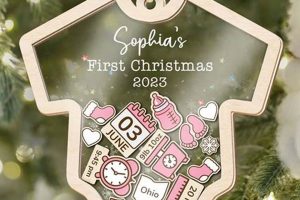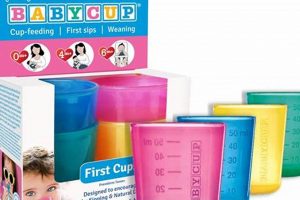The phrase refers to the selection of an optimal drinking vessel with a straw, specifically designed for infants transitioning from bottle or breast feeding. These cups facilitate independent drinking skills. For instance, a cup with weighted straw that allows a baby to drink from any angle, or one with handles for easier gripping.
Introducing such a cup can promote oral motor development, improve hand-eye coordination, and support a smoother transition to independent feeding. Historically, open cups were the standard, but concerns regarding spills and choking led to the development of sippy cups. Straw cups provide an alternative that encourages a more mature drinking pattern closer to that used with an open cup.
The following sections will explore key features to consider when choosing an appropriate product, common concerns encountered during the transition phase, and strategies for successful introduction.
Tips for Introducing an Ideal Initial Straw Cup for Infants
Successful transition to a straw cup often requires patience and a strategic approach. The following tips aim to facilitate a positive and effective experience for both caregiver and infant.
Tip 1: Start Early, But Not Too Early: Introduction can commence around six months of age, when infants typically begin developing the coordination needed to manage a straw. Observe for signs of readiness, such as the ability to sit upright and bring hands to mouth.
Tip 2: Choose a Cup with Features Designed for Beginners: Opt for cups with soft, flexible straws that are gentle on gums. Weighted straws that allow drinking from any angle can also be beneficial. Handles are a plus for infants learning to grasp and hold.
Tip 3: Demonstrate the Drinking Process: Initially, the caregiver may need to demonstrate how to use the straw. This can be achieved by gently squeezing the cup to encourage liquid to reach the straw’s tip or dipping the straw in breast milk or formula.
Tip 4: Offer Water First: When introducing the cup, fill it with water rather than juice or milk. This reduces the risk of developing a preference for sugary drinks and minimizes the mess if spills occur.
Tip 5: Encourage and Praise: Positive reinforcement can motivate the infant. Offer verbal praise and encouragement when the infant attempts to use the cup, even if unsuccessful at first.
Tip 6: Be Patient: Mastery of the straw cup may take time. Avoid pressuring the infant and allow them to learn at their own pace. Consistent, gentle encouragement is key.
Tip 7: Maintain Hygiene: Thoroughly clean the cup and straw after each use to prevent bacterial growth. Follow the manufacturer’s instructions for cleaning and sterilization.
Implementing these strategies can lead to a smoother and more successful transition to straw cup drinking, fostering independence and proper oral motor development.
Having explored crucial tips, the subsequent sections will delve into specific product recommendations and troubleshooting common challenges.
1. Material Safety
Material safety constitutes a critical consideration when selecting the ideal initial straw cup for an infant. The composition of the cup and its components directly impacts the infant’s health and well-being, necessitating stringent evaluation of materials used in manufacturing.
- BPA and Phthalate Content
Bisphenol A (BPA) and phthalates, chemicals formerly prevalent in plastics, have demonstrated potential endocrine-disrupting effects. The selection of a cup explicitly labeled as BPA-free and phthalate-free minimizes the risk of exposure to these substances. Regulatory bodies like the FDA have set limits on allowable levels of these chemicals in products intended for infants.
- Type of Plastic Used
Even within the realm of BPA-free plastics, variations exist. Polypropylene (PP) and Tritan are commonly used due to their durability, heat resistance, and chemical inertness. However, rigorous testing and certification by reputable organizations are vital to verify the safety and suitability of any plastic used in the cup’s construction. Cheaper, less regulated plastics may leach harmful chemicals over time.
- Silicone Components
Silicone is frequently employed for straws and spouts due to its flexibility and resistance to microbial growth. Medical-grade silicone is preferable, as it undergoes stricter quality control measures. Inferior silicone may contain fillers or additives that compromise its integrity and safety.
- Colorants and Additives
The pigments used to color the cup and any additives intended to enhance its properties (e.g., UV resistance) must also be non-toxic and food-grade. Heavy metals and other hazardous substances should be absent. Reputable manufacturers often disclose the types of colorants and additives used in their products.
Thorough evaluation of the materials used in the manufacture of a straw cup is essential for ensuring infant safety. Choosing products that adhere to stringent safety standards and undergo rigorous testing provides reassurance that the selected cup will not pose a health risk to the developing infant.
2. Straw Design
The straw design in a “best first straw cup baby” directly influences the infant’s ability to successfully transition from bottle or breast to independent drinking. Straw characteristics, such as material, size, and valve mechanisms, contribute to ease of use, safety, and the development of proper oral motor skills. Inadequate straw design may lead to frustration, refusal to use the cup, or even choking hazards. For example, a straw made of rigid plastic could irritate gums, while one with an excessively large diameter might overwhelm an infant’s ability to control liquid flow.
Specific design features address common challenges encountered during the transition. Weighted straws permit drinking from various angles, essential for infants who have not yet mastered cup tilting. Valve systems regulate liquid flow, preventing excessive spillage and enabling the infant to control the pace of intake. The material, typically silicone, should be soft and flexible to minimize the risk of injury to the gums and developing teeth. Cup designs often feature a “cross-cut” straw design, which needs the baby to suck to have the liquid released. This is much better than a straw that flows freely, thus increasing the chances of choking and excessive liquid intake.
Therefore, straw design constitutes an integral component of a developmentally appropriate drinking vessel for infants. Careful consideration of material safety, flow regulation, and ergonomic factors ensures a positive drinking experience. Overlooking these elements increases the likelihood of difficulties in the transition to independent drinking, potentially hindering oral motor development and establishing negative associations with cup usage. A well-designed straw, on the other hand, facilitates a seamless and enjoyable learning process.
3. Grip Ergonomics
Grip ergonomics, in the context of an infant’s initial straw cup, pertains to the design features that facilitate a secure and comfortable hold for developing hands. A well-designed grip optimizes the infant’s ability to manipulate the cup independently, promoting self-feeding skills and minimizing frustration. The absence of appropriate grip ergonomics may lead to spillage, difficulty in using the cup, and discouragement in the infant’s attempts at independent drinking.
- Handle Size and Shape
The dimensions and contour of the handles should correspond to the average hand size and grip strength of infants within the target age range. Handles that are too large or awkwardly shaped are difficult for small hands to grasp and maintain a secure hold. Conversely, handles that are too small offer insufficient gripping surface. Ideally, handles feature a slightly curved or contoured shape to conform to the natural curvature of the hand, promoting a more comfortable and stable grip. Examples include handles with a soft, rubberized coating for enhanced friction, or handles angled slightly inward to facilitate a more natural wrist position during drinking.
- Handle Placement and Orientation
The position of the handles relative to the cup’s center of gravity influences the ease with which the infant can control the cup’s movement. Handles positioned too high on the cup may cause it to tip excessively, leading to spills. Placement that is too low can hinder the infant’s ability to see and access the straw. The orientation of the handles should allow for a comfortable and intuitive grip, promoting a natural wrist and arm alignment. Handles oriented horizontally or slightly angled inward are often preferred, as they minimize strain on the infant’s developing muscles.
- Surface Texture and Material
The texture of the gripping surface affects the infant’s ability to maintain a secure hold, particularly when hands are wet or slippery. A slightly textured surface, such as a pattern of raised bumps or ridges, increases friction and prevents the cup from slipping out of the infant’s grasp. The material used for the handles should be non-toxic, durable, and easy to clean. Silicone or rubberized coatings are commonly used due to their grip-enhancing properties and resistance to microbial growth. Avoiding smooth, hard plastic surfaces minimizes the risk of the cup slipping from the infant’s hands.
The integration of thoughtfully designed grip ergonomics into the “best first straw cup baby” enables successful self-feeding, strengthens hand-eye coordination and promotes independence. By optimizing handle size, shape, and placement, manufacturers can facilitate a positive experience that fosters confidence and encourages the development of essential motor skills.
4. Spill Resistance
Spill resistance, a critical attribute of an ideal initial straw cup, directly influences both the infant’s experience and the caregiver’s satisfaction. The connection between spill resistance and the suitability of a “best first straw cup baby” stems from the inherent challenges associated with infants learning to drink independently. Inevitably, clumsy movements, incomplete understanding of cup control, and developmental immaturity lead to frequent spills. Consequently, a cup’s ability to minimize these spills becomes paramount. Poor spill resistance leads to wasted liquids, increased cleaning demands, and potential frustration for both infant and caregiver. For example, a cup without a reliable valve mechanism may leak continuously, discouraging the infant and creating a messy environment.
Effective spill resistance in these cups is achieved through various design elements. Valve systems within the straw restrict liquid flow unless the infant actively sucks, preventing uncontrolled dispensing. Tight-fitting lids and secure seals around the straw’s base also contribute to preventing leaks. Some models incorporate features such as weighted straws or internal mechanisms that allow liquid to flow only when the cup is held upright, further reducing the likelihood of spills. The practical implications of these design features are significant. A cup with superior spill resistance reduces the frequency of clothing changes, minimizes cleaning time, and allows the infant to focus on learning to drink without the distraction of constant spills.
In conclusion, spill resistance serves as a crucial indicator of a “best first straw cup baby” due to its direct impact on usability and convenience. By minimizing messes and fostering a more positive learning experience, a cup with effective spill-resistant features significantly contributes to a smoother transition to independent drinking. Challenges remain in balancing spill resistance with ease of use for the infant, but innovative designs continue to improve the functionality and practicality of these essential products.
5. Ease of Cleaning
Ease of cleaning represents a critical factor in determining the suitability of a “best first straw cup baby.” The direct correlation stems from the inherent susceptibility of infant feeding equipment to bacterial contamination. Residual milk, formula, or juice provides a breeding ground for harmful microorganisms, potentially leading to gastrointestinal distress or other health issues. A cup that is difficult to disassemble and clean thoroughly increases the risk of bacterial growth, directly compromising infant health. For example, cups with intricate valve systems or narrow crevices can trap residue, making adequate cleaning a challenge even with diligent effort.
The importance of ease of cleaning extends beyond simple hygiene. A cup that is readily disassembled into individual components allows for effective sterilization, either through boiling, steaming, or using dedicated sterilizing equipment. Furthermore, the materials used in the cup’s construction should be dishwasher-safe, facilitating convenient and reliable cleaning. Real-world examples include cups designed with minimal parts and wide openings, allowing for easy access with bottle brushes. Cups constructed from durable, non-porous materials resist staining and odor retention, further simplifying the cleaning process. Parents choosing a suitable product should be aware that a cup that is easy to clean protects their child’s health by mitigating exposure to harmful bacteria.
In conclusion, ease of cleaning is inextricably linked to the health and safety of infants using straw cups. The practical significance of this consideration lies in its ability to prevent bacterial contamination and promote hygiene. Cups designed with simple disassembly, dishwasher-safe materials, and easily accessible components contribute to a safer and more convenient feeding experience. Product selection should prioritize ease of cleaning to safeguard infant health and simplify the caregiving routine, effectively improving the quality and value of the cup.
6. Age Appropriateness
Age appropriateness forms a cornerstone in the selection of an initial straw cup for an infant. The suitability of a “best first straw cup baby” hinges on aligning the cup’s design and features with the infant’s developmental stage. A mismatch between the cup’s characteristics and the infant’s capabilities can lead to frustration, hinder skill development, and potentially pose safety risks. Cause and effect are clearly evident: a cup designed for an older child, featuring a large, fast-flowing straw, could overwhelm a six-month-old, leading to choking or liquid aversion. Conversely, a cup with overly restrictive flow may frustrate a toddler capable of managing a larger volume of liquid. The importance of age appropriateness manifests in promoting a positive drinking experience and fostering the development of essential motor skills.
Age appropriateness impacts various facets of cup design. Straw size, flow rate, handle ergonomics, and overall cup weight must be calibrated to the infant’s physical and cognitive abilities. For example, a cup intended for a six-month-old typically features a soft, flexible straw, smaller handles for easier grasping, and a reduced liquid capacity to minimize spillage. Conversely, a cup designed for a toddler may incorporate a larger, more durable straw, contoured handles for enhanced grip, and a higher liquid capacity to accommodate increased fluid intake. The material composition of the cup must also align with age-related safety considerations, ensuring that all components are non-toxic and free of small parts that could pose a choking hazard. Real-life examples abound in product labeling and marketing, where manufacturers explicitly specify the age range for which a particular straw cup is intended.
In summary, age appropriateness represents a critical determinant of a “best first straw cup baby.” A cup selected with careful consideration of the infant’s developmental stage maximizes the likelihood of a successful transition to independent drinking, promotes positive associations with cup usage, and minimizes potential safety risks. While challenges persist in accurately assessing individual developmental variations, adhering to age-related guidelines and observing the infant’s cues can significantly enhance the cup selection process, ensuring that the chosen product effectively supports the infant’s developmental milestones and promotes a safe and enjoyable drinking experience.
Frequently Asked Questions
This section addresses common queries and concerns regarding the selection and use of a “best first straw cup baby.” The information presented aims to provide clarity and support informed decision-making.
Question 1: At what age is it appropriate to introduce a straw cup?
Introduction typically commences around six months of age, coinciding with the development of sitting stability and hand-to-mouth coordination. Observe the infant’s readiness cues, such as showing interest in grasping objects and bringing them to the mouth. Premature introduction can lead to frustration and difficulty in mastering the drinking skill.
Question 2: What materials should be avoided in an infant’s straw cup?
Avoid materials containing Bisphenol A (BPA), phthalates, and PVC. Opt for cups constructed from BPA-free plastics such as polypropylene (PP) or Tritan, and ensure that silicone components are medical-grade. These materials minimize the risk of exposure to potentially harmful chemicals.
Question 3: How frequently should an infant’s straw cup be cleaned?
The cup should be cleaned thoroughly after each use to prevent bacterial growth. Disassemble all components, wash with warm, soapy water, and rinse thoroughly. Periodic sterilization via boiling or steaming is recommended, particularly for infants under six months of age.
Question 4: What features contribute to effective spill resistance?
Valve systems within the straw, tight-fitting lids, and secure seals around the straw base enhance spill resistance. Cups featuring weighted straws or internal mechanisms that regulate liquid flow also minimize spills. Complete spill-proof designs may require excessive suction, making them difficult for infants to use.
Question 5: How can an infant be encouraged to use a straw cup?
Demonstrate the drinking process by gently squeezing the cup to encourage liquid to reach the straw’s tip or dipping the straw in breast milk or formula. Offer positive reinforcement and praise when the infant attempts to use the cup. Consistency and patience are key.
Question 6: What straw design is most suitable for a beginner?
A soft, flexible straw minimizes the risk of gum irritation. A weighted straw allows the infant to drink from various angles, facilitating easier liquid intake. Smaller straw diameters may be preferable initially, as they reduce the risk of overwhelming the infant with excessive liquid flow.
Proper selection and use of a “best first straw cup baby” significantly influences the infant’s transition to independent drinking. Prioritizing safety, hygiene, and age appropriateness promotes a positive learning experience.
The following sections will explore specific product recommendations and troubleshooting common challenges associated with transitioning to straw cup usage.
Concluding Thoughts on Selecting the Optimal Initial Straw Cup
This exposition has explored the multifaceted considerations surrounding the selection of the “best first straw cup baby”. Key elements such as material safety, straw design, grip ergonomics, spill resistance, ease of cleaning, and age appropriateness have been examined, emphasizing their individual and collective impact on infant health, development, and caregiver satisfaction. Careful assessment of these factors is essential for making an informed and responsible purchasing decision.
The transition to independent drinking represents a significant milestone in an infant’s development. The informed application of the principles discussed herein will optimize the likelihood of a successful and positive experience. Future research and innovation in this area should focus on further refining cup designs to better align with evolving developmental needs and safety standards, ensuring that the “best first straw cup baby” continues to support infant health and well-being.







